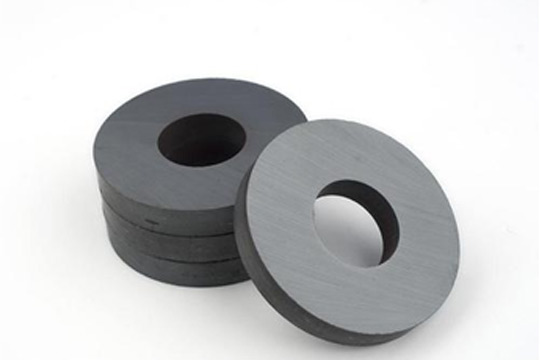Permanent magnet material is also called "hard magnetic material". A material that retains a constant magnetic force once magnetized. It has wide hysteresis loop, high coercivity and high remanence. In practice, the permanent magnet material works in the second quadrant demagnetization of deep magnetic saturation and hysteresis loop after magnetization. The commonly used permanent magnet materials are divided into AlNi Co permanent magnet alloy, Fe-Cr Co permanent magnet alloy, permanent magnet ferrite, rare earth permanent magnet materials and composite permanent magnet materials. Now they are briefly described as follows:
(1) Al-Ni-Co permanent magnet alloy
With iron, nickel and aluminum as the main components, but also contains copper, cobalt, titanium and other elements. With high remanence and low temperature coefficient, magnetic stability. There are two kinds of casting alloy and powder sintering alloy. In the 1930s to 1960s, it was widely used in the instrument industry to manufacture magnetoelectric instruments, flowmeters, micro-special motors, relays and so on.
(2) Fe-Cr-Co permanent magnet alloy
With iron, chromium and cobalt as the main components, it also contains molybdenum and a small amount of titanium and silicon. It has good machinability and can undergo cold thermoplastic deformation. Its magnetic properties are similar to those of Al-Ni-Co permanent magnet alloy, and its magnetic properties can be improved by plastic deformation and heat treatment. It is used to manufacture all kinds of small magnets with small cross section and complex shape.
(3) permanent magnet ferrite
There are mainly barium ferrite and strontium ferrite, which have high resistivity and coercivity, and can be effectively used in the atmospheric gap magnetic circuit, especially suitable for the permanent magnet of small generators and motors. Permanent magnet ferrite does not contain precious metals such as nickel and cobalt, and has rich raw materials, simple process and low cost. It can replace the permanent magnet system of aluminum, nickel and cobalt to make magnetic separator, magnetic push bearing, speakers, microwave devices and so on. But its maximum magnetic energy product is low, temperature stability is poor, the texture is brittle, fragile, not shock vibration resistance, should not be used as measuring instruments and magnetic devices with precision requirements.
(4) Rare earth materials
Mainly rare earth cobalt permanent magnet materials and NdFeB permanent magnet materials. The former is an intermetallic compound formed by rare earth elements such as cerium, praseodymium, lanthanum, neodymium and cobalt. Its magnetic energy product can reach 150 times of carbon steel, 3 ~ 5 times of aluminum-nickelcobalt permanent magnet material, 8 ~ 10 times of permanent magnet ferrite. The temperature coefficient is low, the magnetic stability is stable, and the coercibility is as high as 800 kA/m. Mainly used in low speed torque motor, starting motor, sensor, magnetic bearing magnetic system. NdFeB permanent magnet material is the third generation of rare earth permanent magnet material, its remanent magnetism, coerced force and maximum magnetic energy product is higher than the former, not fragile, has better mechanical properties, low alloy density, is beneficial to the magnetic components of light, thin, small and ultra-small. However, its high magnetic temperature coefficient limits its application.
(5) composite materials
It is composed of a permanent magnetic material powder and a plastic material used as a binder. Because it contains a certain proportion of binder, its magnetic properties are significantly lower than those of the corresponding magnetic materials without binder. In addition to metal composite permanent magnet materials, other composite permanent magnet materials due to the binder heat resistance limit, the use of low temperature, generally not more than 150℃. However, the composite permanent magnet material has the advantages of high dimensional accuracy, good mechanical properties, good uniformity of the properties of each part of the magnet, and is easy to carry out the radial orientation of the magnet and multi-pole magnetization. Mainly used in the manufacture of instruments and meters, communication equipment, rotating machinery, magnetic therapy equipment and sports goods.


